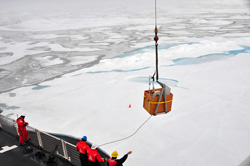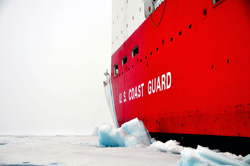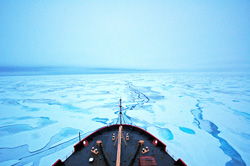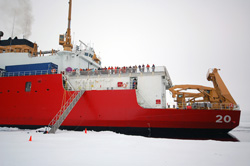September 19thWe steamed east after the ice capades heading now for Amundsen Gulf south of Banks Islands in Canadian waters to run the final transect. Roald Amundsen, by the way, was the first to navigate the Northwest Passage, in 1905, and the strait that bears his name was the last of the really treacherous sections. From there, it was relatively clear sailing in known waters over the Mackenzie Delta and the north coast of Alaska, except of course that a third winter ice-up caught Gjoa. Joseph Banks, the pioneering naturalist and one of the founders of the Royal Society, accompanied Cook on his First Voyage. The Canadian Archipelago is spattered with names of great and not-so-great explorers. Now that yesterday’s present-tense excitement has given way to quiet Monday ship routine, we have calm to think more clearly about the meaning of Arctic ice. I remembered to think of the ice not as a platform for our works and a novel experience, but as a rich natural habitat for animals. What swam beneath us while we worked and played people games? I saw a seal of some kind rolling in the prop-washed, black-water pool astern of Healy as we loaded our gear. We saw bears and Arctic fox tracks, so of course there must be seals, and if seals, then fish and krill, the broad reaches of the food chain. One is struck at first appearance by the hard hostility of the ice environment—it would kill us in hours without our Mustang suits and the shelter of this ship. But we’re not talking about us; we’re trying to think about a chain of organisms for which this is home. That step opens for us delightful levels of ecological insight, but it’s challenging in its multiplicity to grasp at once. The dynamics of Arctic life originate from four basics: water, nutrients, light, and ice. We in the temperate zone perceive time in terms of day-night cycles repeating through the year. In the Arctic year, however, there is one night (dark, ice) and one day (light, less ice) with very brief transitions in between. Tropical and temperate ecosystems are relatively stable because of a predictable infusion of solar energy at a high angle of incidence. The Arctic receives the same annual quantity of sunshine as the tropics, but it comes all at once and at a low angle of incidence. Organisms better hurry up to get what they need; winter lurks just offstage. Arctic ecosystems can experience upheaval and vast die-offs over what in the temperate zones we’d barely notice as “unseasonable weather.” Temperate zones are far more ecologically stable than the Arctic because of their long growing seasons, mild temperatures, and moderate rainfall, but also because they are much older and therefore more completely developed in their ecological relationships. Until about 15,000 years ago, miles of ice covered the Arctic—it literally didn’t exist. Because it is unstable, it is also vulnerable; the Arctic can’t absorb, without collapsing, the same level of human abuse as the temperate zones. Now we’re poised for the explosion of life. Life waits while darkness prevails and ice covers the water. But all the elements are cocked to explode. The ice retreat is the major ecological event in the Arctic, the driver. The narrative of life is circular; nature loves circles. We can’t, therefore, say there is a beginning, a middle, and an end as in literary narratives. So we have to decide where to break into the circle. Bacteria might be a good place. When things die in the ocean, they sink to the bottom (or at least below the “photic zone,” below which light can’t penetrate) where they are munched upon by bacteria. Bacterial action results in a rich soup of nutrients—nitrates, phosphates, iron—essentially the same stuff gardeners use to fertilize their tomatoes, except that it’s in the deep ocean. This same stuff fertilizes those great blooms of phytoplankton we talked about earlier, but that’s getting a little ahead of the story. We still have to get the nutrients up out of the dark depths and near the surface where the phytoplankton can make use of it. As winter settles in on the vast Arctic shelves, ice forms and as it matures, salt is leeched out and forms a layer of dense water directly beneath the ice. Because it’s dense (heavy), that briny water sinks. Doing so, the dense water stirs up the nutrient-rich bottom water and brings it to the sunlit shallows. Now we’re poised for the explosion of life. All we need to set it off is sunlight. In order to bloom phytoplankton need two things: sunlight and nutrients. The nutrients are ready. Now we need light for phytoplankton to photosynthesize; they’re plants, after all. Light doesn’t penetrate very far into the ocean—that’s why we need the nutrients up near the surface. But we still don’t have light because the Arctic night rules, and the sea surface is covered by ice. Earth’s axis tilts back toward the sun—spring is approaching. Air temperature increases, the ice melts. Bam! Now we’ve mixed light and nutrients, and the phytoplankton springs to life in huge blooms. There follows a riot of life. Copepods and a range of other zooplankton come to graze on the phytoplankton. Predator plankton arrive to eat the grazers, then fish to eat the grazers, then seals to eat the fish, bears to eat the seals, and Arctic foxes and birds to scavenge on the remains of the seal carcasses left behind by the bears. It’s a beautiful thing. But wait, if we need light for photosynthesis and this bloom of life, but ice blocks the light, why isn’t a warming Arctic a good thing? Wouldn’t the Arctic be more productive without the ice? No, because we need the ice to produce brine, which sinks, forcing the nutrient-rich water to the surface. It’s true that deep water can reach the surface by other means such as deep mixing by storms and upwelling (also, nutrients borne by currents flow north through the Bering Strait). But storms are localized and seasonal, and upwelling happens only under particular conditions. Also, warming of the surface water enhances stratification, a barrier to deep mixing. These conditions cannot generate the same high-power food chain as when ice is included in this wonderful circle. More immediate, however, is the simple fact that many of the apex predators are, in technical lingo, ice-obligate. In simple language, seals need the ice to feed and breed; polar bears need the ice as a platform from which to hunt the seals, walrus need the floating ice to extend their bottom-foraging range. Take away the ice due to warming, you at least hinder the essential bottom link of the food chain—the phytoplankton blooms. But even if there were some other way for the plankton to bloom without ice, the bears and seals, walrus and the ivory gulls will still vanish unless they completely alter their fundamental modes of existence. After eons of adaptation to this very special environment, not many animals will be able to do that. Instead, they will die. But let’s not leave the story at that sad note. Anyway, we should close the narrative circle for the sake of its integrity by asking, What ends the bloom of life? The phytoplankton use up the nutrients, particularly the nitrogen, and they die, then sink to the bottom where the bacteria goes back to work…. Then the ice returns, and the circle goes around again. (I owe thanks to Sharon, Josh, Brian, and Zach for their patient explanations.) Last updated: September 28, 2010 | ||||||||||||||||||||||
Copyright ©2007 Woods Hole Oceanographic Institution, All Rights Reserved, Privacy Policy. | ||||||||||||||||||||||






